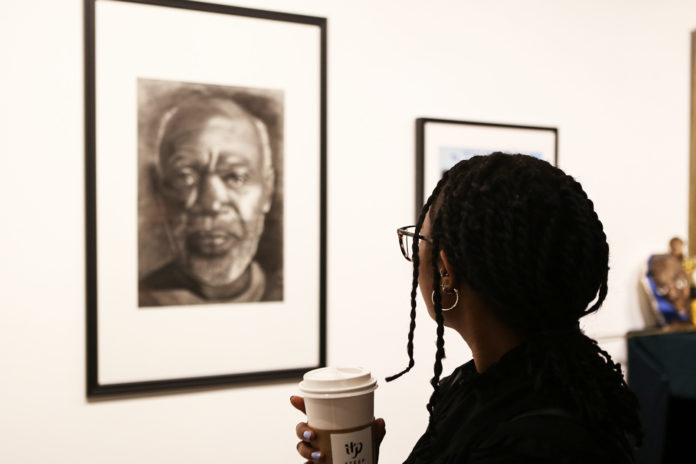
Artist Kayla Salisbury said she created her abstract portrait “Void of Representation Face Study” as an act of rebellion. When she was a student at ArtCenter College of Design, none of the models she studied were black. She was not learning to create art about people she felt were beautiful, she said, gesturing toward the painting. The crowd at the Fellowship of Contemporary Art (FOCA) craned to see the smallest piece in the exhibit “Magician: Black Bodies and Portraiture.” Thick brushstrokes in varying shades of brown acrylic paint form the shape of a face.
“If you were to look at a black person, we have phases of color in our skin. It’s gorgeous,” Salisbury said. “It looks like magic to me.”
“Magician: Black Bodies and Portraiture” opened Feb. 1 and runs until March 28. The exhibit features the works of artists Kayla Shelton, Gozie Ojini, Valerie Asiimwe Amani and Salisbury. It is the first of three exhibits FOCA will curate this year, according to Chair of the FOCA Curators Lab Noriko Fujinami. For curator Jasmine McNeal, the exhibit marks another first — this is her first solo exhibit that she has curated in Los Angeles.
McNeal said she intends for guests to walk the exhibit in a semicircle, starting with Amani’s “Spiritual Orbit” and ending with her piece “Magic Portrait,” which McNeal named the exhibit after. “Magic Portrait” highlights many of the exhibit’s themes as described by McNeal: representation of black bodies, black spirituality and blackness in the contemporary state.
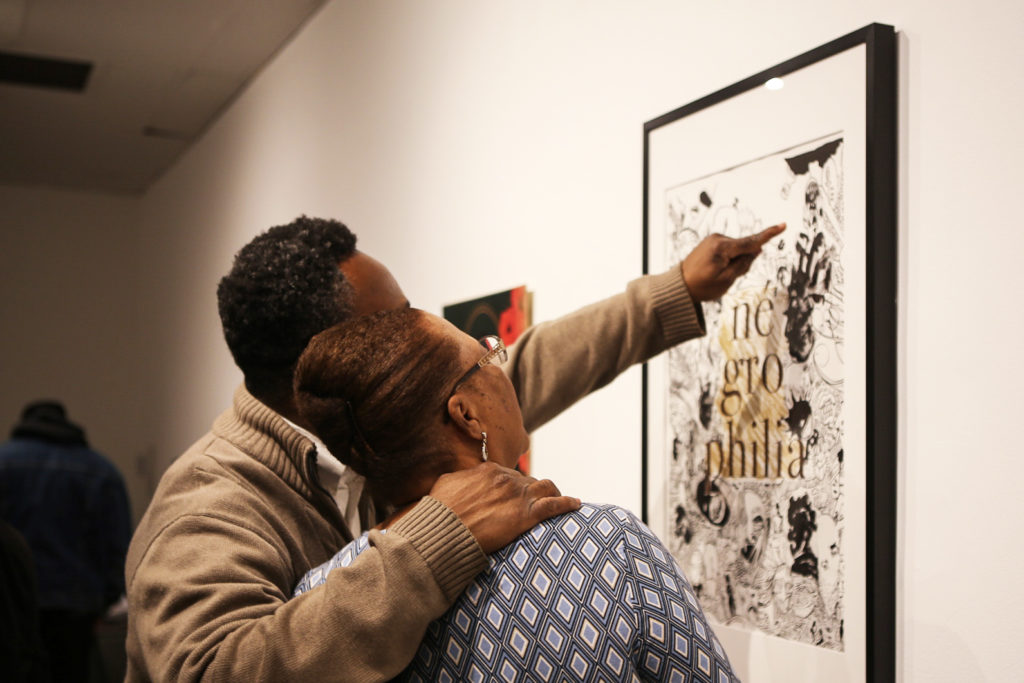
“It’s really hard to talk about contemporary-ness with blackness without referring to the past,” McNeal said. “I really wanted to highlight black spirituality and how pure that is and even without historically Christianity and other religions, how blackness within itself is very spiritual.”
In the corner of the exhibit, McNeal placed Salisbury’s hand-stitched and painted “Oma Dolls” on a black-clothed altar around her painting “Crowned.” She arranged the dolls between red and white flowers, plastic fruits and flickering glass Sacred Heart of Jesus candles. As Salisbury painted more dolls, they began to resemble black people in her neighborhood.
Salisbury did not know that McNeal would display the pieces as an altar. For Salisbury, the altar arrangement elevates the dolls to objects worthy of prayer. McNeal wanted to build a space for black art to thrive.
“I created the altar to give respect to our ancestors and to blackness in a contemporary setting,” McNeal said.
The subjects of many of Shelton’s mixed media portrait collages are from the early 1900s. Her piece “Untitled II” features a photo of a South African choir member taken in London in 1891. Shelton sees herself as an archivist — she researches old photos and places them in a new context.
“The original portraits almost seem to be stoic and so sad,” Shelton said. “My goal is to make them look regal and present a certain kind of importance. But also when I look at this, I see so much energy and life in them.”
Shelton said that other than “Untitled II,” none of the other photos she used are historically identified. A woman glanced in the direction of Shelton’s other works.
“It makes me wonder who they are,” she said.
Salisbury said she does not know the subject of her painting “Portrait of a Black Man.” She said the painting was inspired by a homeless man she met in San Francisco.
“I wanted to look into his soul. And something that’s funny about that is everyone who sees it, they’re like ‘That looks like my grandpa,’” Salisbury said.
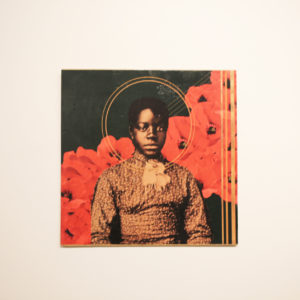
Exhibition visitor Sheri Johnson stares at Salisbury’s piece “Negrophilia” and points out some of the elements of black culture in the piece — the hair, masks, acrylic nails and a reference to the song “Bonita Applebum” by A Tribe Called Quest. Salisbury said the piece contains imagery of appreciation for black culture, but also elements of cultural appropriation and black stereotypes. Johnson interpreted the word “negrophilia” to be about people’s obsession with black aesthetics.
“They don’t want the struggle of protesting, but they want our asses,” Johnson said.
She took another look at the piece and paused.
“We sometimes don’t see the value in our diversity because we’re not taught to value blackness,” Johnson said.
Occupying the center of the exhibit is Ojini’s sculpture “Portal.” Ojini created the sculpture by attaching a beaded curtain to a metal detector. The piece is interactive, and McNeal encouraged guests to walk through.
The beads spell out quotes from students, faculty and district attorneys about the use of metal detectors in schools and their psychological impact.
“This is a tool to keep schools safe it has always been seen and used that way,” one strand reads.
Guests play with the bead strands and peer through the piece on both sides. Not many people choose to walk through it.
“Everything from the time you enter the building is telling you that this is punishment that education is like jail why would they believe they are capable of anything else,” reads another strand.
Exhibition visitor Steve Wong said he was drawn to “Portal” because of its timeliness in an era of school shootings. For Wong, the piece asks the question of who is actually being protected with the use of metal detectors.
“Is the metal detector a band-aid for a more systemic issue in the United States?” Wong said.
In his description of “Portal,” Ojini calls it a “visual placebo.”
Ojini said it is interesting that both of his pieces “Portal” and “Untitled” are in a portraiture exhibit even though there are no bodies present. Wong said he saw “Portal” as a kind of self-portrait.
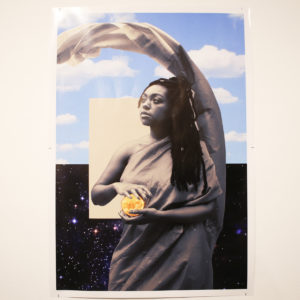
Wong bent down to take a picture of Ojini’s piece “Untitled,” which was resting on the floor. Encased inside a clear plexiglass box is a pair of white Nike Air Force 1 shoes covered in patches of black mold. Condensation builds on the inside ceiling of the box as the mold continues to spread.
Black mold is almost everywhere, according to Ojini, but it needs the right environment to grow. First, it needs cellulose, which Ojini said is present in the cotton in the shoes. Second, the mold requires water. Finally, Ojini said black mold is delicate and needs a contained space, such as the sealed plexiglass box, to flourish.
“You question whether we’re protected from it or if the mold is protected from us,” Ojini said.
The black mold’s growth is out of his control, Ojini said. He does not know if the mold will eventually take over the shoes. The black mold is a stand-in for black bodies, Ojini said, but he does not want to champion the metaphor over the reality of what is happening: black mold is growing on a pair of shoes.
Many of the works in the exhibit — including this piece by Ojini — are untitled. None of the works have a name card attached to them; instead, McNeal printed out guides with the information on each piece for guests to read. McNeal said she ran out of time to print cards to accompany each piece. The lack of names prompted guests to ask more questions.
“It helps you figure out how to interpret it,” Salisbury said. “Maybe you start to look at your own biases and your mentality and you leave here a better person.”
“Magician: The Black Body and Portraiture” is on display until March 28 at FOCA in Chinatown at 970 N. Broadway St. in Suite 208.
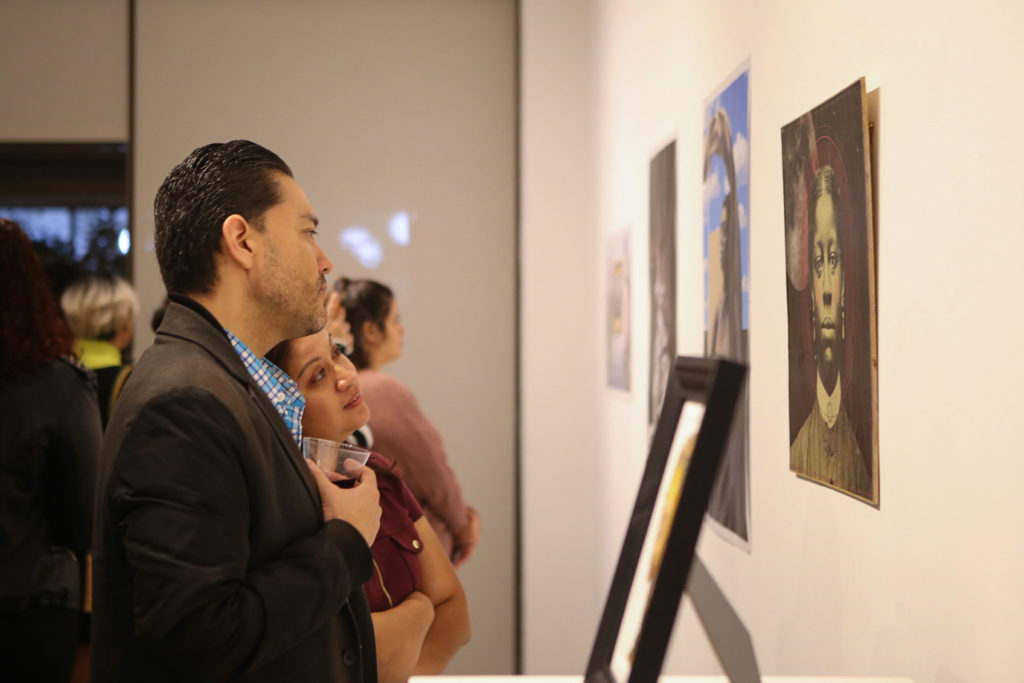
![]()



































